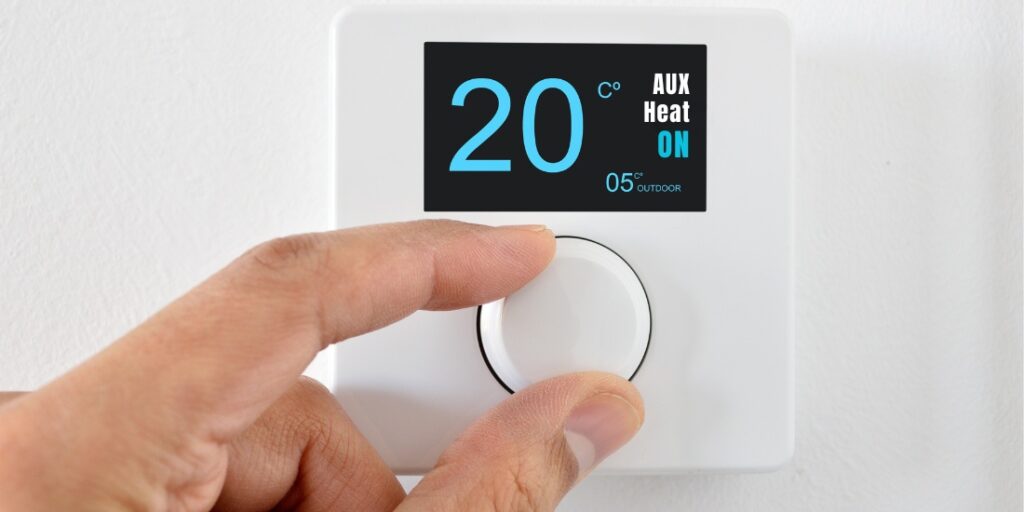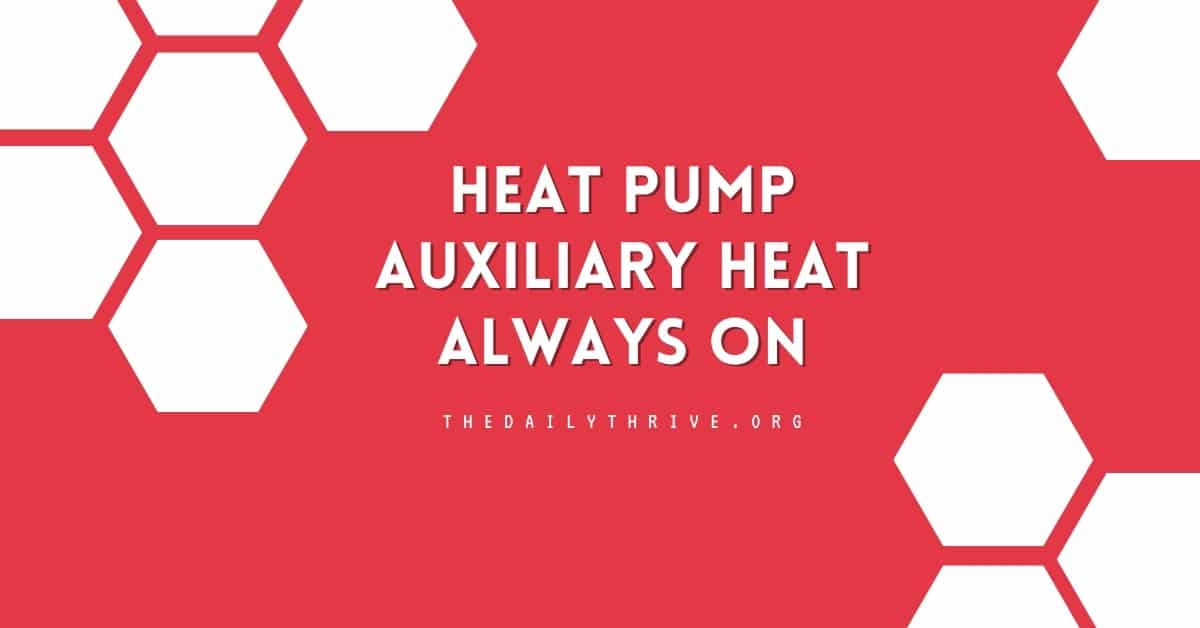Throughout my career specializing in home improvement and HVAC systems, I’ve discovered that homeowners often encounter confusion regarding their heating systems, especially regarding heat pumps and their reliance on auxiliary heat. This particular function, typically indicated by an “AUX heat” alert on the thermostat, is intended to be a supplementary heating source, activating only when the external temperatures are so low that the primary heat pump can’t maintain a comfortable indoor climate on its own.
As the colder season sets in, it is fairly common to see the auxiliary heat come into play, offering an additional layer of warmth when outdoor conditions become too chilly for the heat pump to handle effectively. However, the transition of auxiliary heat from intermittent support to a permanent solution raises several issues—it’s a situation that can heat up not just the interiors of a home but also the numbers on energy bills, leading to potential mechanical stress on the heat pump system.
The question arises: what prompts the heat pump auxiliary heat to always be on in constant operation?
Is it a response to persistently low outdoor temperatures, or could it be due to an excessively high thermostat setting? Or, more critically, does this indicate a mechanical defect within the heat pump itself?
Understanding the auxiliary heat’s function is crucial to discerning its appropriate usage within your home’s heating regimen. It’s built to offer quick heating solutions in times of need—when the heat pump can’t sufficiently warm your home or when a swift temperature increase is manually commanded via the thermostat. A perpetual “AUX heat” status is a warning signal that requires prompt investigation and resolution.
This article will delve into why auxiliary heat may run continuously, examining the potential impacts on system efficiency and homeowner costs. By understanding these factors, we can guide how to maintain a heat pump’s effective and economical performance, ensuring comfortable homes without unnecessary expense.
Understanding the Heat Pump Auxiliary Heat Function
In cooler climates, the auxiliary heat setting on a heat pump is not just a feature but a necessity. It’s engineered to provide that extra boost to your heating system, ensuring that your home reaches the desired temperature swiftly, especially during the cold winter months.

Heat pumps are lauded for their ability to control temperature efficiently, utilizing significantly less energy than traditional systems. They achieve this through a reverse cycle that cools the home in warmer weather, offering year-round comfort regardless of external conditions.
However, heat pumps are not the fastest runners in the race to achieve your desired temperature. This is the gap that auxiliary heat is designed to fill. As a backup system, it uses electric heating elements to give a quick and powerful dose of heat when the heat pump alone isn’t cutting it.
The intent is for the AUX heat to work in concert with the main heat pump, striking a balance between maintaining comfort and keeping energy costs low.
When is Auxiliary Heat Activation Normal?
It’s important to know that there are several normal circumstances under which the auxiliary heat should activate:
1. External Temperatures Drop Below 35°F
Heat pumps draw warmth from outside air to heat the home. When the mercury drops near or below freezing, the heat pump may struggle to find sufficient warmth outside. This is when the AUX heat steps in to provide the necessary additional heating power.
2. Thermostat Adjustment of 3 Degrees or More
When there’s a significant, rapid change requested via the thermostat—typically around 3 degrees or more—the heat pump will enlist the aid of the AUX heat to quickly reach the new setting. For instance, bumping the temperature from 62°F to 68°F will likely trigger the AUX heat to ensure your morning chill is quickly replaced with cozy warmth.
3. The Heat Pump Is in Defrost Mode
To maintain efficiency and operation, heat pumps will periodically enter a defrost cycle to clear any ice buildup around the coils. During this cycle, the system may temporarily rely on auxiliary heat to prevent a dip in indoor temperature. Indicator lights or messages may be displayed during this short-lived process to inform you of the defrost mode.
By understanding these functions and normal activation scenarios, homeowners can better diagnose whether their system’s use of auxiliary heat is appropriate or indicates an issue needing professional attention.
The Auxiliary Heat Issue: When There’s a Problem?
Encountering the auxiliary heat feature on your heat pump running incessantly can be a clear signal that something is amiss. This section aims to dig deeper into what constitutes a problem with auxiliary heat and how to recognize it.
When auxiliary heat is functioning properly, it serves as an infrequent but powerful ally against the cold. If, however, you notice that the AUX heat seems to be constantly in action, it’s a red flag signaling potential issues with your heat pump system.
Let’s explore the symptoms and warning signs that could indicate trouble:
1. Sudden Increase in Your Electricity Bill
Familiarity with the typical cost of running your heat pump is crucial. A noticeable spike in energy consumption, particularly when you haven’t changed your heating habits, suggests the AUX heat is operating more than necessary. This is often the most palpable indicator that homeowners first notice.
2. AUX Heat Activation in Warm Weather
Auxiliary heat kicking in when the temperatures are above 35°F is unusual. If you find that the AUX heat is persistently running on a warm day, it’s an unwelcome and unnecessary operation that could signify a malfunction within the system.
3. Unresponsive to Thermostat Adjustments
Normally, adjusting the thermostat to match the ambient indoor temperature should deactivate the AUX heat. If the auxiliary system continues to run regardless of the thermostat setting, it points to a possible fault in the system’s communication or control mechanisms.
4. Overheated Indoor Spaces
When your home’s interior reaches excessively high temperatures, yet the AUX heat remains ON, it indicates that the system is not properly regulating itself. This could be due to a misread by the thermostat or a mechanical issue within the heat pump.
5. Defrost Mode Light Constantly On
The heat pump should enter defrost mode only when the coils are frosted over, and it should exit this mode quickly once the ice is cleared. A defrost light that stays on is a telltale sign that the defrost cycle is stuck, which can lead to continuous auxiliary heat usage.
If any of these symptoms appear, it’s best to take immediate action. Often, the fix might be as simple as recalibrating the thermostat or replacing a faulty sensor. However, addressing the issue promptly can prevent further complications and ensure that your system continues to operate efficiently and economically.
If troubleshooting the thermostat or examining the outdoor unit for ice doesn’t resolve the issue, don’t hesitate to contact a professional. HVAC technicians are equipped to diagnose and repair any underlying issues, ensuring that your heat pump system remains a reliable source of comfort for your home.
Troubleshooting Heat Pump Auxiliary Heat Always On
Before you conclude that a service call is necessary, there are several troubleshooting actions you can take to possibly resolve the issue of auxiliary heat being constantly on. These steps not only can save you the expense of a professional visit but may also prevent future occurrences by ensuring proper maintenance and settings.
Here’s what you can do:
1# Thermostat Settings
Start with the simplest component: the thermostat. Verify that it’s set to the appropriate mode for heating and that the desired temperature isn’t set too high, which can trigger AUX heat. Also, check that the thermostat itself is functioning correctly. If you have a programmable thermostat, ensure the settings haven’t been accidentally altered.
2# Check the Air Filters
A clogged air filter can restrict airflow and cause the heat pump to work harder, sometimes triggering the AUX heat to compensate for the lack of air movement. Check your filters regularly – at least once a month during heavy use – and replace them as needed. This is one of the easiest and most cost-effective ways to ensure your system runs efficiently.
3# Outdoor Unit Inspection
Take a look at the outdoor unit. Ice, snow, leaves, and other debris can obstruct the heat exchange, prompting the system to rely on auxiliary heat. Gently remove any debris and carefully de-ice the unit if necessary. However, be cautious with how you remove ice; avoid using sharp objects that can damage the coils.
4# System Reset
Sometimes, like your electronics, your HVAC system may need a reset. Turn off the power to your heat pump at the breaker, wait a minute, and then turn it back on. This can sometimes clear minor electronic glitches that may cause the system to behave erratically.
5# Listen for Unusual Noises
While the system is running, listen for any unusual noises, such as grinding, banging, or whistling. These could indicate mechanical issues that need professional attention.
6# Check for Error Codes
Many modern heat pumps have diagnostic systems that display error codes when there’s a problem. Refer to your owner’s manual to understand what these codes mean, as they can provide specific insights into what might be malfunctioning.
If, after performing these checks, the auxiliary heat is still running continuously, it’s time to consult a professional HVAC technician. It’s essential to relay any observations you’ve made and actions you’ve taken, as this information can be incredibly helpful for the technician in diagnosing and fixing the problem more quickly.
Remember, regular maintenance is key to preventing issues. An annual service check by a professional can keep your system in top shape and help avoid unexpected problems with auxiliary heat or any other component of your heat pump.
In summary, it’s crucial to understand that the auxiliary heat function of your heat pump is designed as a temporary support to maintain comfort during extreme cold snaps or when a rapid temperature increase is needed. It’s not intended for persistent use. Running your AUX heat continuously is akin to pushing your vehicle’s engine into the red zone incessantly; it’s impractical and can lead to premature wear and potentially expensive repairs.
If you find that your heat pump auxiliary heat is always on or is engaging more often than it should, it’s wise to investigate and rectify the situation swiftly. By doing so, you can preserve the integrity of your heat pump system, keep your energy expenses in check, and ensure a comfortable and cost-effective climate in your home year-round.






